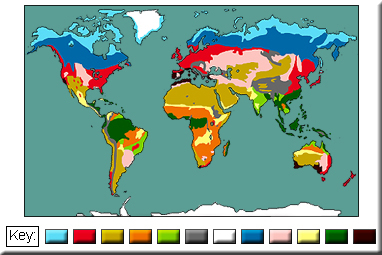|
****JavaScript
web menu drop down DHTML menu generated by NavStudio. (OpenCube Inc.
- http://www.opencube.com)****
|
||||
|
A meadow showing a diversity of flowers |
Species are not evenly distributed over the world but form
a variety of spatial patterns.
Investigations of biodiversity at the ecological level seek to explain why these spatial patterns occur and what their significance is for understanding global biodiversity. Of the three levels of biodiversity, the ecological level is the hardest to define and delineate in a hierarchy. One way to describe ecological systems is in the form of disctinct
biomes. |
|||
Ecological Classification HierarchyThe ecological level of biodiversity is the hardest to classify in a hierarchy. The Global Biodiversity Assessment [Heywood 1995] , gives the following hierarchy:
None of the ways of classifying or mapping diversity at the ecological level are as universally recognised as the conventional taxonomic hierarchy of kingdom > phylum > class > genus > species. The boundaries of these levels of ecological diversity are often difficult to identify. There are also differences between aquatic and terrestrial classification schemes. There is also potential confusion between the terms ecosystem and ecological system or unit. The Earth as a whole, the marine realm, a biome, a landscape, etc. are all ecological systems and units. Ecosystem has currency as a specific term describing a functional and also spatially defined unit (e.g. a particular forest or lake) within the hierarchy. |
||
|
|
BiomesThis [Whittaker 1975] defines a biome as follows:
There are several other ways of classify and mapping ecological units at the biome level.
|
|

